PORSCHE BOXSTER S 2011 2.G Information Manual
Manufacturer: PORSCHE, Model Year: 2011, Model line: BOXSTER S, Model: PORSCHE BOXSTER S 2011 2.GPages: 66, PDF Size: 11.53 MB
Page 21 of 66
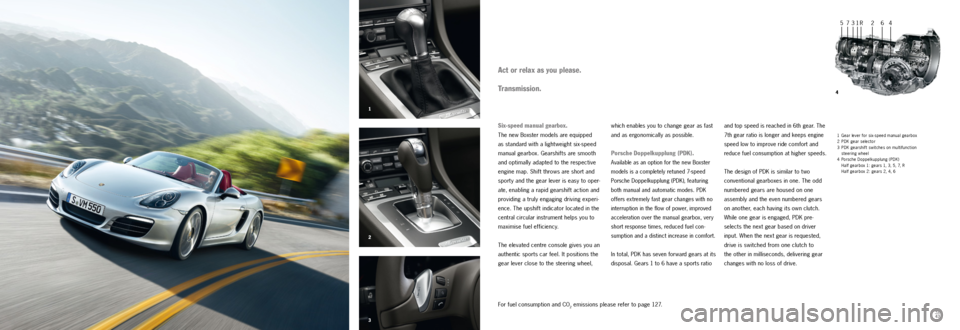
2 1
3
4
6
2
1 R
7 3
5
4
42
4342
43
Six-speed manual gearbox.
The new Boxster models are equipped
as standard with a light weight six-speed
manual gearbox. Gearshifts are smooth
and optimally adapted to the respective
engine map. Shift throws are short and
sport y and the gear lever is easy to oper -
ate, enabling a rapid gearshift action and
providing a truly engaging driving experi -
ence. The upshift indicator located in the
central circular instrument helps you to
maximise fuel efficiency.
The elevated centre console gives you an
authentic sports car feel. It positions the
gear lever close to the steering wheel, which enables you to change gear as fast
and as ergonomically as possible.
Porsche Doppelkupplung (PDK).
Available as an option for the new Boxster
models is a completely retuned 7-speed
Porsche Doppelkupplung (PDK), featuring
both manual and automatic modes. PDK
offers extremely fast gear changes with no
interruption in the flow of power, improved
acceleration over the manual gearbox, very
short response times, reduced fuel con
-
sumption and a distinct increase in comfort.
In total, PDK has seven forward gears at its
disposal. Gears 1 to 6 have a sports ratio
Act or relax as you please.
Transmission.
and top speed is reached in 6th gear. The
7th gear ratio is longer and keeps engine
speed low to improve ride comfort and
reduce fuel consumption at higher speeds.
The design of PDK is similar to t wo
conventional gearboxes in one. The odd
numbered gears are housed on one
assembly and the even numbered gears
on another, each having its own clutch.
While one gear is engaged, PDK pre-
selects the next gear based on driver
input. When the next gear is requested,
drive is switched from one clutch to
the other in milliseconds, delivering gear
changes with no loss of drive.
For fuel consumption and CO
2 emissions please refer to page 127.
1 Gear lever for six-speed manual gearbox
2 PDK gear selector
3 PDK gearshift switches on multifunction
steering wheel
4 Porsche Doppelkupplung (PDK)
H a l f ge a r b ox 1: ge a rs 1, 3, 5, 7, R
Half gearbox 2: gears 2, 4, 6
Page 22 of 66

For ward thrust |
Transmission
For fuel consumption and CO2 emissions please refer to page 127.
Coasting.
The coasting function available with
Porsche Doppelkupplung (PDK) enables
you to save even more fuel where the
situation allows. The engine is decoupled
from the transmission to prevent
deceleration caused by engine braking.
In this way, optimum use is made of
the vehicle’s momentum, allowing it to
coast for longer distances.
For example, you may want to slow down
from 60 mph to 40 mph in anticipation
of the change of speed limit ahead. As
you ease off the accelerator pedal, PDK
deselects the current gear automatically
and you begin to coast in neutral until
you have reached your desired speed. As
soon as you operate the accelerator or brake pedal, PDK re-engages the appro
-
priate gear within fractions of a second.
The process is smooth and seamless
thanks to the extremely fast clutch.
Another way to reduce fuel consumption
is to utilise the coasting function on
downhill gradients that are gentle enough
for you to maintain a constant speed.
Efficient on long journeys, such as on the
motorway, PDK remains ready to respond
as swiftly and precisely as you would
expect.
In short, driving in coasting mode makes
a real impact on fuel consumption with -
out any need for compromise on comfort
or sporty performance.
With the SPORT but ton selected, the full
advantages of the new version of PDK
are brought into play: a more immediate
response to throt tle inputs, even shorter
shift times and swift, throttle-blip down -
shifts on overrun and when braking –
always accompanied by an emotive engine
sound.
With the optional Sport Chrono Package,
PDK is enhanced by the ‘Launch Control’
and ‘motorsport- derived gearshif t strategy’
functions (p. 63) for even faster gear
changes and the best possible per formance
thanks to a boost in torque during upshift
phases. Overrun downshifts provide
extremely sport y braking and acceleration
for added excitement.
Page 23 of 66
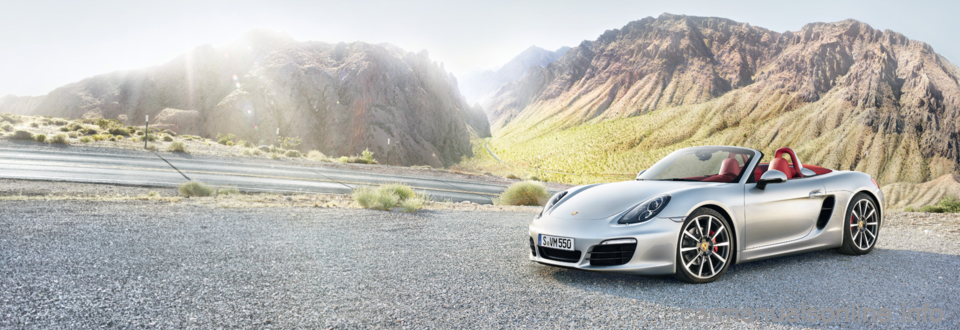
Page 24 of 66
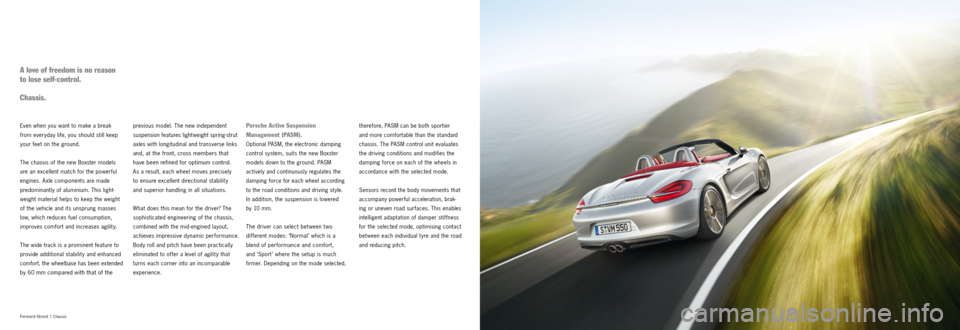
Even when you want to make a break
from everyday life, you should still keep
your feet on the ground.
The chassis of the new Boxster models
are an excellent match for the powerful
engines. Axle components are made
predominantly of aluminium. This light -
weight material helps to keep the weight
of the vehicle and its unsprung masses
low, which reduces fuel consumption,
improves comfort and increases agility.
The wide track is a prominent feature to
provide additional stability and enhanced
comfort, the wheelbase has been extended
by 60 mm compared with that of the
previous model. The new independent
suspension features lightweight spring-strut
a
xles with longitudinal and transverse links
and, at the front, cross members that
have been refined for optimum control.
As a result, each wheel moves precisely
to ensure excellent directional stability
and superior handling in all situations.
What does this mean for the driver? The
sophisticated engineering of the chassis,
combined with the mid-engined layout,
achieves impressive dynamic performance.
Body roll and pitch have been practically
eliminated to offer a level of agilit y that
turns each corner into an incomparable
experience.
A love of freedom is no reason
to lose self-control.
Chassis.
Porsche Active Suspension
Management (PASM).
Optional PASM, the electronic damping
control system, suits the new Boxster
models down to the ground. PASM
actively and continuously regulates the
damping force for each wheel according
to the
road conditions and driving st yle.
In addition, the suspension is lowered
by 10 mm.
The driver can select bet ween t wo
dif ferent modes: ‘Normal’ which is a
blend of performance and comfort,
and ‘Sport ’ where the setup is much
firmer. Depending on the mode selected,
For ward thrust |
Chassis
therefore, PASM can be both sportier
and more comfortable than the standard
chassis. The PASM control unit evaluates
the driving conditions and modifies the
damping force on each of the wheels in
accordance with the selected mode.
Sensors record the body movements that
accompany powerful acceleration, brak -
ing or uneven road surfaces. This enables
intelligent adaptation of damper stif fness
for the selected mode, optimising contact
bet ween each individual t yre and the road
and reducing pitch.
Page 25 of 66
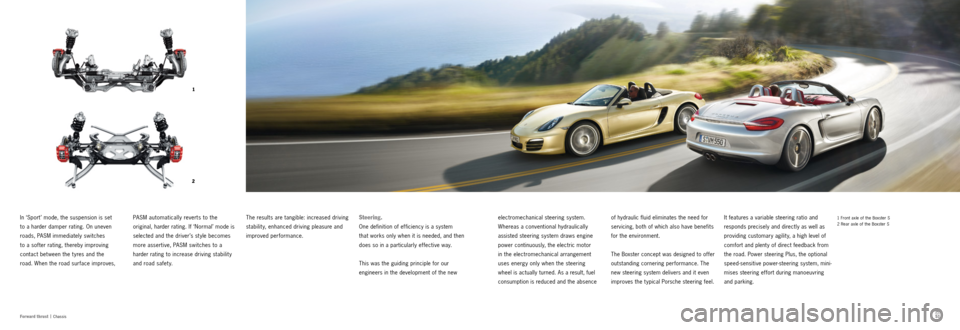
1
2
50 515051
For ward thrust |
Chassis
In ‘Sport ’ mode, the suspension is set
to a harder damper rating. On uneven
roads, PASM immediately switches
to a softer rating, thereby improving
contact bet ween the t yres and the
road. When the road surface improves, PASM automatically reverts to the
original, harder rating. If ‘Normal’ mode is
selected and the driver’s st yle becomes
more assertive, PASM switches to a
harder rating to increase driving stability
and road safet y. The results are tangible: increased driving
stability, enhanced driving pleasure and
improved performance.
Steering.
One definition of efficiency is a system
that works only when it is needed, and then
does so in a particularly effective way.
This was the guiding principle for our
engineers in the development of the new
electromechanical steering system.
Whereas a conventional hydraulically
assisted steering system draws engine
power continuously, the electric motor
in the electromechanical arrangement
uses energy only when the steering
wheel is actually turned. As a result, fuel
consumption is reduced and the absence of hydraulic fluid eliminates the need for
servicing, both of which also have benefits
for the environment.
The Boxster concept was designed to of fer
outstanding cornering performance. The
new steering system delivers and it even
improves the typical Porsche steering feel. It features a variable steering ratio and
responds precisely and directly as well as
providing customary agility, a high level of
comfort and plent y of direct feedback from
the road. Power steering Plus, the optional
speed -sensitive power-steering system, mini
-
mises steering ef fort during manoeuvring
and parking.
1 Front a xle of the Boxster S
2 Rear axle of the Boxster S
Page 26 of 66
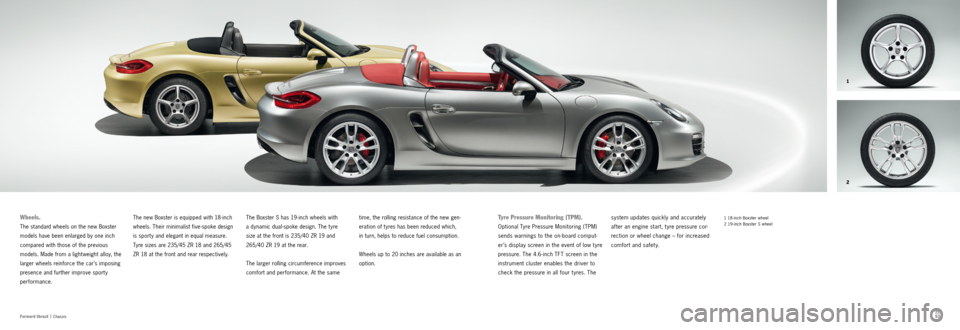
1
2
52
5352
53
For ward thrust |
Chassis
Wheels.
The standard wheels on the new Boxster
models have been enlarged by one inch
compared with those of the previous
models. Made from a light weight alloy, the
larger wheels reinforce the car’s imposing
presence and further improve sport y
performance. The new Boxster is equipped with 18-inch
wheels. Their minimalist five-spoke design
is sport y and elegant in equal measure.
Tyre sizes are 235/45 ZR 18 and 265/45
ZR 18 at the front and rear respectively.
The Boxster S has 19-inch wheels with
a dynamic dual-spoke design. The t yre
size at the front is 235/40 ZR 19 and
265/40 ZR 19 at the rear.
The larger rolling circumference improves
comfort and performance. At the same time, the rolling resistance of the new gen
-
eration of t yres has been reduced which,
in turn, helps to reduce fuel consumption.
Wheels up to 20 inches are available as an
option.
Tyre Pressure Monitoring (TPM).
Optional Tyre Pressure Monitoring (TPM)
sends warnings to the on-board comput -
er’s display screen in the event of low t yre
pressure. The 4.6-inch TFT screen in the
instrument cluster enables the driver to
check the pressure in all four t yres. The system updates quickly and accurately
after an engine start, t yre pressure cor
-
rection or wheel change – for increased
comfort and safet y.
1 18 - inch Boxster wheel
2 19 - inch Boxster S wheel
Page 27 of 66

12 3
54
555455
Brakes.
Porsche brakes set standards worldwide
for stopping power and stability. For
the new Boxster models, braking per for -
mance is as essential as driving perfor -
mance.
Both models are equipped with four-
piston aluminium monobloc fixed calipers
at the front and rear. This design means
that, not only are the brakes extremely
resistant to deformation, they are light -
weight for a particularly fast and sensitive
braking response.
The new generation of brake caliper at
the front axle, combined with enlarged
brake pads and the newly developed
brake booster, has managed to improve braking and component stability even
during continuous use. These two charac
-
teristics have also been optimised by the
newly developed brake ventilation system
with a modified air spoiler at the front
and rear axles.
The enhanced dynamics of the Boxster
and Boxster S also demand appropriate
brake discs. All Boxster brake discs are
internally vented and cross-drilled for
improved braking in wet conditions. On
the Boxster S, the diameter of the front
brake discs has been enlarged by 15 mm
to 330 mm. At the rear, the diameter is
the same as on the Boxster – 299 mm
The brake calipers on the Boxster and
Boxster S are black and red respectively.
Porsche Ceramic Composite Brake
(PCCB).
From the start, Porsche has been synon -
ymous with motorsport. Ever since
1948, when we found our identit y on the
racetrack, we have taken the experience
we have gained and applied it to the
road. The optional Porsche Ceramic
Composite Brake (PCCB) is a fine exam -
ple. This brake system has already had
to cope with the harshest requirements
of motor racing and is fit ted in cars
that compete in demanding events such
as the Porsche Mobil 1 Supercup.
The cross-drilled PCCB ceramic brake
discs for the new Boxster have a diame -
ter of 350 mm front and rear for even
more formidable braking performance. The use of six-piston aluminium mono
-
bloc fixed brake calipers on the front
axle and four-piston units at the rear –
all finished in yellow – ensures extremely
high brake forces which, crucially, are
exceptionally consistent.
PCCB enables shorter braking distances
in even the toughest road and race
conditions. Excellent fade resistance
ensures greater balance when slowing
from racetrack speeds.
1 Standard brake on the Boxster
2 Standard brake on the Boxster S
3 Porsche Ceramic Composite Brake (PCCB)
Page 28 of 66
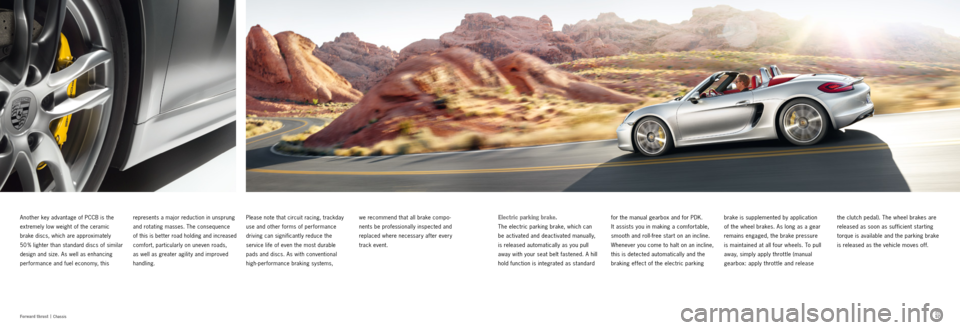
56575657
For ward thrust |
Chassis
Another key advantage of PCCB is the
extremely low weight of the ceramic
brake discs, which are approximately
50 % lighter than standard discs of similar
design and size. As well as enhancing
performance and fuel economy, this represents a major reduction in unsprung
and rotating masses. The consequence
of this is bet ter road holding and increased
comfort, particularly on uneven roads,
as well as greater agilit y and improved
handling. Please note that circuit racing, trackday
use and other forms of performance
driving can significantly reduce the
service life of even the most durable
pads and discs. As with conventional
high-performance braking systems, we recommend that all brake compo
-
nents be professionally inspected and
replaced where necessary after every
track event.
Electric parking brake.
The electric parking brake, which can
be activated and deactivated manually,
is released automatically as you pull
away with your seat belt fastened. A hill
hold function is integrated as standard for the manual gearbox and for PDK.
It assists you in making a comfortable,
smooth and roll-free start on an incline.
Whenever you come to halt on an incline,
this is detected automatically and the
braking effect of the electric parking brake is supplemented by application
of the wheel brakes. As long as a gear
remains engaged, the brake pressure
is maintained at all four wheels. To pull
away, simply apply throttle (manual gearbox: apply throt tle and release the
clutch pedal). The wheel brakes are
released as soon as sufficient starting
torque is available and the parking brake
is released as the vehicle moves off.
Page 29 of 66

58595859
Porsche Stability Management (PSM).
Enhanced Porsche Stability Management
(PSM) is fit ted as standard. This system
automatically maintains stability even
at the limits of dynamic driving perfor -
mance. Sensors continuously monitor
the speed, yaw velocit y and lateral
acceleration of the car. Using this
information, PSM is able to calculate the
actual direction of travel at any given
moment. If the car begins to oversteer or
understeer, PSM applies selective braking
on individual wheels in order to restore
stability. Under acceleration on wet or low-grip
road surfaces, PSM improves traction –
as well as agilit y and safet y – using the
automatic brake differential (ABD) and
anti-slip regulation (ASR). Integrated ABS
is designed to minimise braking distances.
If you prefer an ever sportier drive, PSM
can be switched off. For your safet y,
however, PSM remains set to intervene if
the vehicle is braked and ABS assistance
is required. ABS and ABD remain switched on at all times. Also included with PSM
are engine drag torque control (EDC),
precharging of the brake system and
brake assist. If you suddenly release the
accelerator pedal, PSM automatically
prepares for your next action: the braking
system is precharged so that the brake
pads are already in light contact with the
brake discs. Maximum braking power is therefore achieved much sooner. Brake
assist detects a panic braking situation
and generates the brake pressure
required for maximum deceleration.
For ward thrust
|
Chassis
Page 30 of 66

60616061
Porsche Torque Vectoring (PTV).
This optional system for increasing
dynamic performance and stability varies
the distribution of torque to the rear
wheels and includes a mechanically lock -
ing rear differential. When the car is driven assertively into
a corner, moderate brake pressure is
applied to the inside rear wheel. Conse -
quently, a greater amount of drive force
is distributed to the outside rear wheel,
inducing an additional rotational pulse (yaw movement) around the vehicle’s
vertical axis. This results in a direct and
sport y steering action as the car enters
the corner. At low and medium vehicle speeds, PT V
significantly increases agilit y and steering
precision. At high speeds and when
accelerating out of corners, the rear differ -
ential lock ensures greater driving stabilit y on a range of surface conditions, includ
-
ing the wet and snow.
The results are remarkable stabilit y, easier
handling and outstanding traction as
well as
greater agilit y at every speed with
For ward thrust |
Chassis
precise steering and stable load transfer
characteristics. What else? As ever, lots
of
excitement at every t wist and turn.